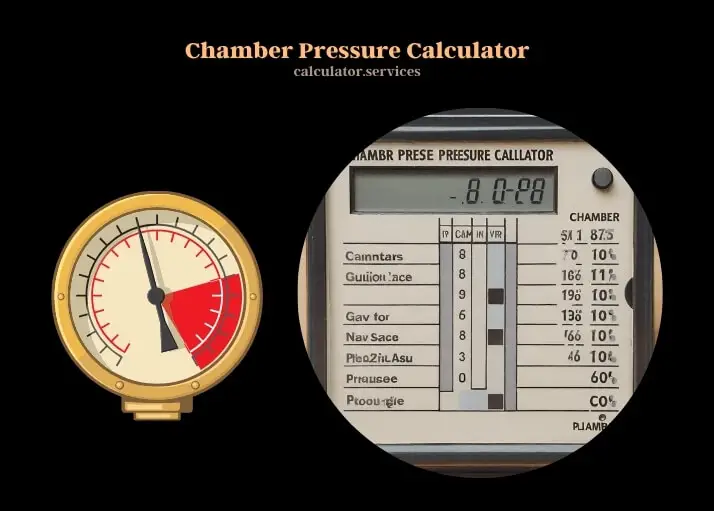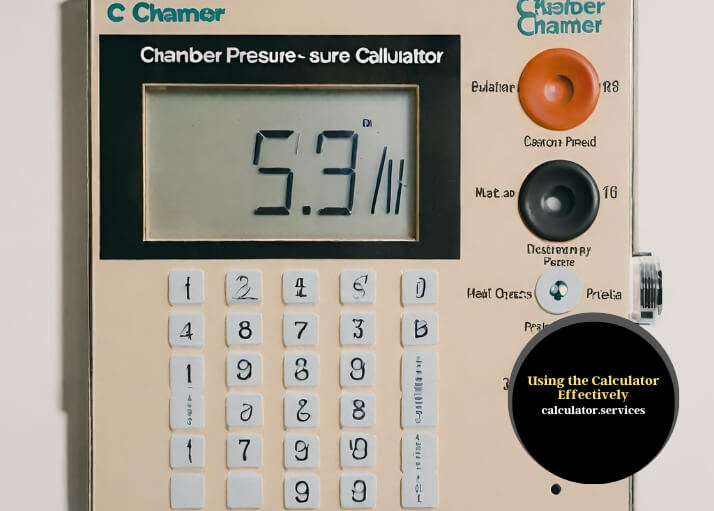Published on: February 29, 2024
Created by Calculator Services Team / Fact-checked by Monjurul Kader
Chamber Pressure Calculator
Calculate the chamber pressure of a rocket engine.
A chamber pressure calculator is a tool designed to calculate the pressure inside the combustion chamber of a rocket engine. This calculation is vital for engineers and enthusiasts involved in rocketry, as it helps in designing engines that are both efficient and safe.
The chamber pressure in a rocket engine plays a pivotal role in its overall performance. It directly influences the thrust generated by the engine, which is essential for the rocket to overcome gravitational forces during lift-off. The calculator simplifies the complex equations involved in determining this pressure, making it accessible to both professionals and hobbyists. By inputting variables such as the net force acting on the piston, the area of the piston, the mass flow rate of the propellant, and several others, users can obtain an accurate measure of chamber pressure. This measure is crucial for optimizing engine design and ensuring the structural integrity of the rocket during flight.
The use of such calculators has democratized access to advanced aerospace calculations, enabling a broader range of people to participate in rocket design and experimentation. It serves as an educational tool as well, allowing students and enthusiasts to gain practical insights into the physics of rocketry. The calculator is designed to be user-friendly, requiring no advanced knowledge of the underlying mathematical principles.
We invite you to use the chamber pressure calculator available on our website for your projects and learning. By leveraging this tool, you can achieve a deeper insight into the dynamics of rocket engines and enhance your designs. Read the detailed article below to learn more about how this calculator can be a valuable asset in your aerospace endeavors.

See More Useful Calculators:
- Bob Weight Calculator
- Picture Spacing Calculator
- Cable Railing Calculator
- C Channel Span Calculator
- Unsprung vs Sprung Weight Calculator
- Zipp Tire Pressure Calculator
Chamber Pressure
The Role of Chamber Pressure in Rocket Engines
Chamber pressure acts as the heart of a rocket engine, pumping the thrust needed to propel rockets into space. Like the blood pressure in our veins dictates the health of our body, chamber pressure determines the vitality and performance of a rocket engine. It’s the force per unit area exerted by the combustion gases on the walls of the engine’s combustion chamber, directly influencing the engine’s thrust and, by extension, the rocket’s ability to reach orbit.
Impact on Rocket Performance and Efficiency
The efficiency of a rocket engine hinges on its ability to convert fuel into thrust. This conversion is significantly affected by the chamber pressure. Higher pressures generally mean more efficient combustion and better thrust, akin to squeezing a water hose to shoot water further. However, this also means the engine components must withstand greater stresses, balancing a tightrope between performance and durability.
The Calculation Formula
Basic Formula
P=AF+k⋅Vm˙⋅(k−1)⋅R⋅T
In this formula:
- P represents the chamber pressure.
- F is the net force acting on the piston.
- A stands for the area of the piston.
- m˙ denotes the mass flow rate of the propellant.
- k is the specific heat ratio of the propellant.
- R represents the specific gas constant of the propellant.
- T is the flame temperature.
- V indicates the volume of the combustion chamber.
Key Parameters Explained
Net Force and Its Influence
Net force (F) on the piston is the push that initiates the movement of the rocket. It’s the spark that lights the fire, setting the stage for the rocket’s journey. The area (A) of the piston, meanwhile, is the stage itself, determining how widely the force is spread.
Mass Flow Rate
The mass flow rate (˙m˙) of the propellant is akin to the fuel flow in a car. Just as a car needs a steady supply of fuel to keep moving, a rocket engine needs a constant flow of propellant to maintain thrust.
The Significance of Specific Heat Ratio and Gas Constant
The specific heat ratio (k) and specific gas constant (R) are the character traits of the propellant, defining how it behaves under pressure and temperature. They’re the DNA of the rocket’s fuel, determining how well it converts heat into work.
Flame Temperature and Volume Considerations
Flame temperature (T) and combustion chamber volume (V) are the environment and space where the magic of propulsion happens. Higher temperatures mean more energetic gas particles, while the volume of the chamber is like the size of a stage for a play, determining how much room the performance has to unfold.
Practical Examples
Sample Calculations with Varying Parameters
| Net Force (N) | Area (m²) | Mass Flow Rate (kg/s) | Resulting Chamber Pressure (Pa) |
|---|---|---|---|
| 5000 | 0.007 | 0.02 | 714285714.29 |
| 6000 | 0.008 | 0.025 | 750000000 |
This table showcases how altering just one variable can shift the entire outcome, illustrating the delicate balance engineers must maintain when designing rocket engines.
Using the Calculator Effectively

Tips for Accurate Measurements
Accuracy in measurements is like hitting the bullseye in archery; it requires focus, understanding, and practice. Ensuring each parameter is precisely measured can mean the difference between a successful launch and a failed mission.
Common Pitfalls and How to Avoid Them
Missteps in calculations can lead to catastrophic failures. Being vigilant about double-checking inputs and understanding the interplay between variables can safeguard against these pitfalls.
Impact of Incorrect Parameters
| Parameter | Common Mistake | Impact on Calculation |
|---|---|---|
| Mass Flow Rate | Underestimation | Significantly lower pressure |
| Specific Heat Ratio | Overestimation | Unrealistically high pressure |
Mistakes in parameter estimation can lead to wildly inaccurate calculations, underscoring the importance of precision and verification in rocketry.
Summary
The chamber pressure calculator is a bridge between theoretical physics and practical rocketry, offering a window into the complex dynamics of rocket engine performance. By understanding and accurately applying the variables in the calculation formula, engineers and enthusiasts alike can optimize designs for efficiency and reliability. This article has illuminated the path through the intricate dance of variables that govern the heart of rocket engines, providing the tools to master the art and science of rocket propulsion.
